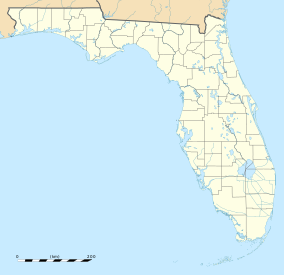| Bill Baggs Cape Florida State Recreation Area | |
|---|---|
| IUCN category IV (habitat/species management area) | |
 | |
  | |
| Location | 1200 South Crandon Boulevard Miami-Dade County, Florida, U.S. |
| Nearest city | Key Biscayne, Florida |
| Coordinates | 25°40′25″N 80°09′34″W / 25.673611°N 80.159444°W / 25.673611; -80.159444 |
| Area | 400 acres (160 ha) |
| Established | 1967 |
| Visitors | 850,000 (in 2004) |
| Governing body | Florida Department of Environmental Protection |
Bill Baggs Cape Florida State Recreation Area occupies approximately the southern third of the island of Key Biscayne, at coordinates 25°40′25″N 80°09′34″W / 25.67361°N 80.15944°W / 25.67361; -80.15944. This park includes the Cape Florida Light, the oldest standing structure in Greater Miami. In 2005, it was ranked as having the 8th best beach in the country, and in 2013 Forbes ranked it at 7th.
The park was named in honor of Bill Baggs, editor of The Miami News from 1957 until his death in 1969. He worked to protect the land from development and to preserve some of the key in its natural state.
In 2004 a large historical marker was erected at the site to mark it as part of the National Underground Railroad Network to Freedom Trail, as hundreds of Black Seminoles, many fugitive slaves, escaped from here to freedom in the Bahamas, settling mostly on Andros Island. In the early 1820s, some 300 American slaves reached the Bahamas, aboard 27 sloops and many canoes. The US National Park Service is working with the Bahamas, particularly the African Bahamanian Museum and Research Center (ABAC) in Nassau, to develop interpretive programs at Red Bays, Andros.
Recreational activities
The park has more than a mile of sandy Atlantic beachfront, where snorkeling and swimming is possible. Besides the beach and tours of the lighthouse and keeper's quarters, activities include boating, canoeing, kayaking and fishing from the seawall along Biscayne Bay, bicycling, hiking and wildlife viewing. The park has such amenities as picnicking areas and youth camping. It also has a visitor center, a museum with interpretive exhibits and concessions. No Name Harbor, a natural harbor in the park, is used for anchorage.
Hours
Florida state parks are open between 8 a.m. and sundown every day of the year (including holidays).
Gallery
-
 Entryway
Entryway
-
 Sea grapes at the park
Sea grapes at the park
-
 Interpretive kiosk and building
Interpretive kiosk and building
-
 Path leading to the beach
Path leading to the beach
-
 Cape Florida Lighthouse
Cape Florida Lighthouse
-
 Sign commemorating Black Seminoles who escaped from Cape Florida in the early 1820s to the Bahamas
Sign commemorating Black Seminoles who escaped from Cape Florida in the early 1820s to the Bahamas
References
- Bill Baggs Cape Florida State Park, Florida State Parks website
- "Best beaches in U.S.? Expert ranks his 'Top 10'", NBC News
- "Dr. Beach". Archived from the original on March 5, 2013. Retrieved July 2, 2020.
- Bender, Andrew (May 24, 2013). "America's Top 10 Beaches of 2013". Forbes.com.
- Charles Blacker Vignoles, Observations on the Floridas, New York: E. Bliss & E. White, 1823, pp. 135-136
- Partners: "African Bahamanian Museum and Research Center (ABAC)", Network to Freedom, National Park Service, accessed 10 April 2013
Further reading
- Rosalyn A. Howard, Black Seminoles in the Bahamas, Gainesville: University of Florida, 2002
External links
- Bill Baggs Cape Florida State Park Archived January 14, 2015, at the Wayback Machine - official site
- Bill Baggs Cape Florida State Park Archived January 14, 2015, at the Wayback Machine at Florida State Parks
- Bill Baggs Cape Florida State Recreation Area at Absolutely Florida
- Bill Baggs Cape Florida State Park at South Florida Sun-Sentinel
- Cape Florida and the Bill Baggs State Recreation Area at key-biscayne.com
| Greater Miami Area | |
|---|---|
| Central business district | |
| Major urban areas | |
| Colleges and universities |
|
| Parks and recreation |
|
| Attractions |
|
| Major shopping centers |
|
| Transportation |
|
| Major thoroughfares |
|